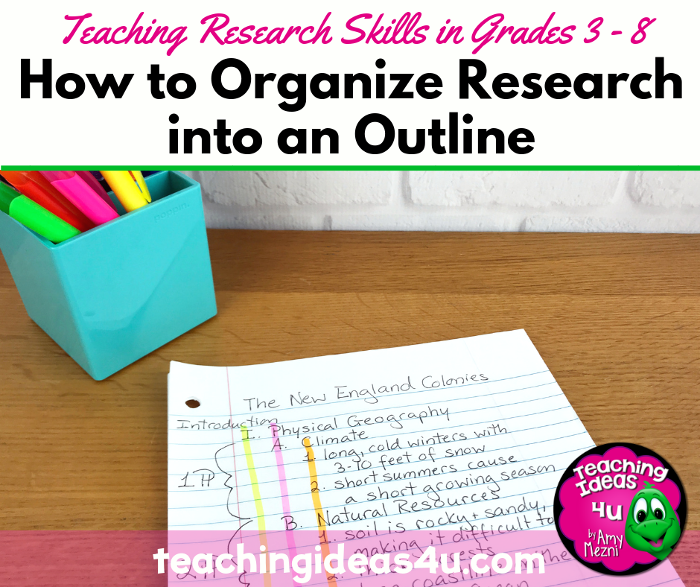How to Organize a Research Paper Outline
Outlining is an underappreciated skill. Neither of my own kids learned to outline in their classes, and it seems like outlining has gone out of fashion. However, it is the one skill that I taught students that really knocked their socks off!
You might think I’m crazy, but it’s true. When the outline is complete, and you show students how easy it is to write their essays, it is like magic. I have had students come back and thank me years later.
Outlining can be used for any form of writing. It can be used to plan entire books or short stories. However, I think the best time to teach outlining is during a research project. Research projects have specific topics, subtopics, and details, which makes it easy to organize information into an outline.
So what is the trick to getting students to appreciate outlining? Model, model, model. (You probably already guessed that if you read my other posts.)
Getting Organized
Before trying to teach outlining, students must have their notes organized. That is why I recommend using index cards to take research notes. Students can move facts around and place them in order if they are on note cards. This can be done using a separate page of notes for each subtopic, but I find smaller chunks of information to better.
Model, Model, Model
I recommend creating a simple outline in front of students before allowing them to do anything. Create a simple outline with a topic, 2-3 body paragraphs, and a closing, then tell them you can write your essay in just a few minutes.
This is where you grab them. Students won’t believe you, so you make a huge deal out of it – how it is so easy, it’s like magic. Then go ahead and write the essay as quickly as you can – just start a timer or write down your start time first. Because students want to see if you really can write that quickly, they pay close attention.
As I write the essay, I think aloud. I simply explain how I can take the fragments on the outline and turn them into sentences. I usually finish in 5 – 10 minutes. For your reluctant writers, this is a powerful moment because they start to realize writing doesn’t have to be hard.
After wowing them, write a class outline together. If you use a textbook, you can use a short lesson as the text to outline. Use the class notes on the lesson to use as your information, then create the outline together. Because everyone already has the notes, it is an essay way to practice.
During the practice outline, be sure to have kids practice with partners or on their own. I start by asking students the overall topic (lesson title is a hint), then I outline the first section of the lesson. For the next section, I have students either work with a shoulder partner or independently (their choice). Once students finish, we add the subtopic to the class outline. This allows students to check their work.
Continue outlining the lesson in this manner. The goal is a gradual release of support so that students can work independently.
Creating the Research Paper Outline
If you are not sure how to create an outline, it is actually pretty easy. Here are a few simple rules:
1. One of the most important things in outlining is to line up each level. Indents are important. Outlines always shift right as you work toward more specific details. By indenting, it is easy to see where a new paragraph begins. (At this level, each new topic is usually a new paragraph.) Ex. Topic > Subtopic > Detail
2. Outlines always begin with Roman Numerals. They are used for the topics.
3. Main ideas are represented by capital letters. Go to the next line and indent.
4. Details about the main idea are marked with numbers (1, 2, 3, etc.). These details should begin on the line after the subtopic. They should be indented past the subtopic.
5. Some outlines do have sub-details, but I would try to stay away from them if students are new to outlining. Sub-details are marked with lowercase letters.
I also recommend making the first topic (Roman numeral I) be the Topic or Thesis statement. That not only reminds students of their topic but also to write an introductory paragraph. I also have students make the final topic “conclusion.”

